In J. R. R. Tolkien's fictional legendarium, Beleriand was a region in northwestern Middle-earth during the First Age. Events in Beleriand are described chiefly in his work The Silmarillion, which tells the story of the early ages of Middle-earth in a style similar to the epic hero tales of Nordic literature, with a pervasive sense of doom over the character's actions. Beleriand also appears in the works The Book of Lost Tales, The Children of Húrin, and in the epic poems of The Lays of Beleriand.

The Battle of Helm's Deep, also called the Battle of the Hornburg, is a fictional battle in J. R. R. Tolkien's The Lord of the Rings that saw the total destruction of the forces of the Wizard Saruman by the army of Rohan, assisted by a forest of tree-like Huorns.
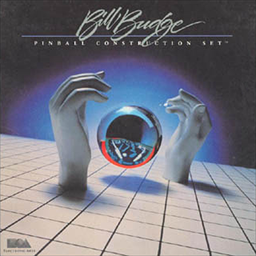
Pinball Construction Set is a video game by Bill Budge written for the Apple II. It was originally published in 1982 through Budge's own company, BudgeCo, then was released by Electronic Arts in 1983 along with ports to the Atari 8-bit computers and Commodore 64.

Julian Clare May was an American science fiction, fantasy, horror, science and children's writer who also used several literary pseudonyms. She is best known for her Saga of Pliocene Exile and Galactic Milieu Series books.
Scott O'Dell was an American writer of 26 novels for young people, along with three novels for adults and four nonfiction books. He wrote historical fiction, primarily, including several children's novels about historical California and Mexico. For his contribution as a children's writer he received the biennial, international Hans Christian Andersen Award in 1972, the highest recognition available to creators of children's books. He received The University of Southern Mississippi Medallion in 1976 and the Catholic Libraries Association Regina Medal in 1978.

Galway Mills Kinnell was an American poet. His dark poetry emphasized scenes and experiences in threatening, ego-less natural environments. He won the Pulitzer Prize for Poetry for his 1982 collection, Selected Poems and split the National Book Award for Poetry with Charles Wright. From 1989 to 1993, he was poet laureate for the state of Vermont.

David Macaulay is a British-born American illustrator and writer. His works include Cathedral (1973), The Way Things Work (1988), and its updated revisions The New Way Things Work (1998) and The Way Things Work Now (2016). His illustrations have been featured in nonfiction books combining text and illustrations explaining architecture, design, and engineering, and he has written a number of children's fiction books.
Suzanne Hubbell was an American author. Her books A Country Year and A Book of Bees were selected by The New York TimesBook Review as Notable Books of the Year. She also wrote for The New Yorker, the St. Louis Post-Dispatch, Smithsonian and Time, and was a frequent contributor to the "Hers" column of The New York Times.
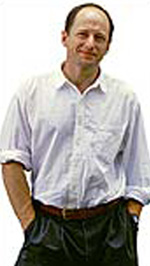
Rick Bass is an American writer and an environmental activist. He has a Bachelor of Science in Geology with a focus in Wildlife from Utah State University. Right after he graduated, he interned for one year as a Wildlife Biologist at the Weyerhaeuser Timber Company in Arkansas. He then went onto working as an oil and gas geologist and consultant before becoming a writer and teacher. He has worked across the United States at various universities: University of Texas at Austin, Beloit College, University of Montana, Pacific University, and most recently Iowa State University. He has done many workshops and lectures on writing and wildlife throughout his career. Texas Tech University and University of Texas at Austin have collections of his written work.

Microsoft Bookshelf is a discontinued reference collection introduced in 1987 as part of Microsoft's extensive work in promoting CD-ROM technology as a distribution medium for electronic publishing. The original MS-DOS version showcased the massive storage capacity of CD-ROM technology, and was accessed while the user was using one of 13 different word processor programs that Bookshelf supported. Subsequent versions were produced for Windows and became a commercial success as part of the Microsoft Home brand. It was often bundled with personal computers as a cheaper alternative to the Encarta Suite. The Encarta Deluxe Suite / Reference Library versions also bundled Bookshelf.

Silene coronaria, the rose campion, is a species of flowering plant in the family Caryophyllaceae, native to Eurasia. Other common names include dusty miller, mullein-pink and bloody William. In the United Kingdom it is still widely referenced under its synonym Lychnis coronaria.
Simon Jowett is a British author and scriptwriter.
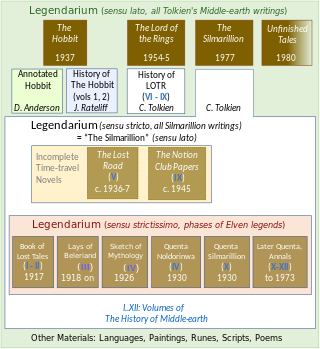
Tolkien's legendarium is the body of J. R. R. Tolkien's mythopoeic writing, unpublished in his lifetime, that forms the background to his The Lord of the Rings, and which his son Christopher summarized in his compilation of The Silmarillion and documented in his 12-volume series The History of Middle-earth. The legendarium's origins reach back to 1914, when Tolkien began writing poems and story sketches, drawing maps, and inventing languages and names as a private project to create a mythology for England. The earliest story, "The Voyage of Earendel, the Evening Star", is from 1914; he revised and rewrote the legendarium stories for most of his adult life.
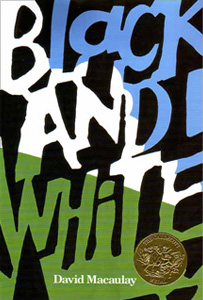
Black and White is a 1990 postmodern children's picture book by David Macaulay. Published by Houghton Mifflin Company, it received mixed reviews upon its release. It was the recipient of the Caldecott Medal for illustration in 1991. The book tells four overlapping stories, each drawn with a distinct visual style: "Seeing Things", about a boy on a train trip by himself, "Problem Parents", about siblings whose parents behave differently one night, "A Waiting Game", about people waiting for a train, and "Udder Chaos", about cows who escape and then return to their field.

Pinball 2000 was the last pinball hardware and software platform developed by major pinball manufacturer Williams, and was used in the machines Revenge From Mars and Star Wars Episode I before Williams exited the pinball business on October 25, 1999. It is the successor to the Williams Pinball Controller platform.

The first season of Saturday Night Live, an American sketch comedy series, originally aired in the United States on NBC from October 11, 1975, to July 31, 1976. The show served as a vehicle that launched to stardom the careers of a number of major comedians and actors, including Chevy Chase, John Belushi, and Dan Aykroyd.
Cynthia Zarin is an American poet and journalist.
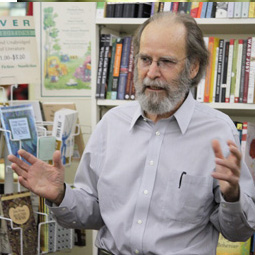
Dale Peterson is an American author who writes about scientific and natural history subjects.
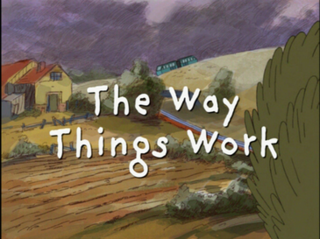
The Way Things Work was a short-lived children's television series based on the best-selling book of the same name by David Macaulay. The series was co-produced by Millimages, Pearson Broadband, and Schlessinger Media; it was distributed by the latter. The program ran daily on BBC2 and CBBC from 2001 to early 2002, before it was discontinued due to a lack of both episodes and audience. The series (hand-animated) was one of the last few educational TV programmes still shown by the BBC on CBBC. It is one of its most short-lived television series, running for only 26 15-minute episodes. The programme aims to teach basic principles of science to young viewers and revolves around the residents of the backward Mammoth Island as they struggle through daily life with the use of outlandish contraptions. The series was later dubbed into French and briefly aired in syndication on TV network France 5. A DVD containing all 26 episodes of the series was released in 2005.

The Stars: A New Way to See Them is an astronomy book by H. A. Rey. It was first published in 1952 and revised in 1962. It was updated again in 1997. Other editions were: Chatto and Windus, London, 1975; "A New Way to see the Stars", Paul Hamlyn, London, 1966; Enl. World-wide ed. Houghton Mifflin, 1967.















